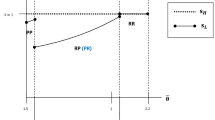Abstract
In a vertically differentiated Cournot oligopoly where the high-quality variant of the good requires the use of high-quality labor, firms may either all supply the same quality or differentiate their product. In differentiated configurations the number of firms choosing to supply the high-quality variant is generally above the optimum. The opening of trade between symmetric countries entails a pro-competitive effect that raises welfare through a reduction in average quality. This result contrasts with previous findings concerning the opening of trade in vertically differentiated oligopolistic industries (Gabszewicz, Shaked, Sutton, and Thisse,International Economic Review 22 [1981]; Shaked and Sutton, in Kierzkowski, ed.,Monopolistic Competition and International Trade, Oxford 1984).
Similar content being viewed by others
References
Baldwin, R. E. (1994):Towards an Integrated Europe. CEPR, London.
Bonanno, G. (1986): “Vertical Differentiation with Cournot Competition.”Economic Notes 15:69–91.
Brander, J., and Krugman, P. (1983): “A Reciprocal-Dumping Model of International Trade.”Journal of International Economics 15:313–321.
Copeland, B. R., and Kotwal, A. (1996): “Product Quality and the Theory of Comparative Advantage.”European Economic Review 40:1745–1761.
Courakis, A. S. (1991): “Labour Skills and Human Capital in the Explanation of Trade Patterns.”Oxford Economic Papers 43:443–462.
Daly, A., Hitchens, D., and Wagner, K. (1985): “Productivity, Machinery and Skills in a Sample of British and German Manufacturing Plants.”National Institute Economic Review 0 (111):48–61.
De Fraja, G. (1996): “Product Line Competition in Vertically Differentiated Markets.”International Journal of Industrial Organization 14:389–414.
Fontagne', L., Freudenberg, M., and Peridy, N. (1997): “Trade Patterns Inside the Single Market.” Document de Travail no. 97-7, CEPII.
Gabszewicz, J., and Thisse, J.-F. (1979): “Price Competition, Quality, and Income Disparities.”Journal of Economic Theory 20:340–359.
Gabszewicz, J., Shaked, A., Sutton, J., and Thisse, J.-F. (1981): “International Trade in Differentiated Products.”International Economic Review 22:527–534.
Gal-Or, E. (1983): “Quality and Quantity Competition.”Bell Journal of Economics 14: 590–600.
Greenaway, D., and Torstensson, J. (1998): “Economic Geography, Comparative Advantage and Trade Within Industries: Evidence from the OECD.” Paper presented at the ZEI-CEPR Workshop on Product Quality, Labour Productivity and Trade, Bonn, Germany, January.
Gros, D., and Gonciarz, A. (1996): “A Note on the Trade Potential of Central and Eastern Europe.”European Journal of Political Economy 12:709–721.
Krugman, P. (1979): “Increasing Returns, Monopolistic Competition and International Trade.”Journal of International Economics 9:469–480.
Mason, G., Van Ark, B., and Wagner, K. (1996): “Workforce Skills, Product Quality and Economic Performance.” InAcquiring Skills, edited by A. Booth and D. J. Snower. Cambridge: Cambridge University Press.
Motta, M. (1992): “Sunk Costs and Trade Liberalisation.”Economic Journal 102: 578–587.
— (1993): “Endogenous Quality Choice: Price vs. Quantity Competition.”Journal of Industrial Economics 41:113–129.
Murphy, K. M., and Shleifer, A. (1997): “Quality and Trade.”Journal of Development Economics 53:1–15.
Mussa, M., and Rosen, S. (1978): “Monopoly and Product Quality.”Journal of Economic Theory 18:301–317.
Oulton, N. (1996): “Workforce Skills and Export Competitiveness.” InAcquiring Skills, edited by A. Booth and D. J. Snower. Cambridge: Cambridge University Press.
Shaked, A., and Sutton, J. (1983): “Natural Oligopolies.”Econometrica 51:1469–1483.
—, (1984): “Natural Oligopolies and International Trade.” InMonopolistic Competition and International Trade, edited by H. Kierzkowski. Oxford: Clarendon Press.
Steedman, H., and Wagner, K. (1987): “A Second Look to Productivity, Machinery and Skills in Britain and Germany.”National Institute Economic Review 0 (122):84–95.
Webster, A. (1993): “The Skill and Higher Educational Content of UK Net Exports.”Oxford Bulletin of Economics and Statistics 55:141–160.
Author information
Authors and Affiliations
Rights and permissions
About this article
Cite this article
Turrini, A. High-quality bias in vertically differentiated oligopolies—a note on skills, trade, and welfare. Zeitschr. f. Nationalökonomie 71, 133–147 (2000). https://doi.org/10.1007/BF01227448
Received:
Revised:
Issue Date:
DOI: https://doi.org/10.1007/BF01227448




